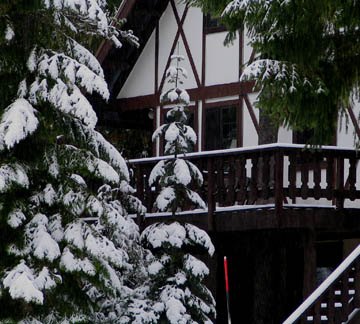
Winterizing - winter landscape preparation
Photograph: mountain home at Government Camp on Mt. Hood in Oregon - Cascade Mountains in winter

advertisement
Copyright 2009 - Mario D. Vaden
This information is good for Portland, Seattle and the Pacific NW. There are only a few steps needed for winterizing a landscape.

1. Irrigation systems should be winterized: drains opened, lines that can freeze cleared. One product that may help insulate irrigation valve boxes, or meter boxes, is spray foam insulation. Turn the lids upside down, fill with foam, allow the procuct to dry, then slice off excess with a long blade or saw.
2. Trees drop leaves; leaves clog gutters; clogged gutters trap water; water freezes, expands and dislodges the hardware fastening it. Good winterizing includes gutter cleaning. This can improve drainage in many yards, where overflowing gutters may dump too much water on the soil. When gutters and downspouts are cleared of debris, water can flow away through drain pipes as needed. Feel free to check out our page about drainage and French drains.
3. Not just in winter, but by fall, the lawn should be fertilized with a low nitrogen fertilizer appropriate for turf. This may be the single most important fertilizing of the year to winterize a lawn. Fall fertilizer is to grass, like antifreeze is to a vehicle radiator. Fall fertilizing allows grass to hold up to cold and freezing better.
4. Make sure that exposed ends of drain lines are clear from obstruction.
5. Apple tree leaves harbor fungus spores - don't leave apple tree leaves and fruit on the ground in winter.
6. Salts or granules use for melting snow, can wash into the lawn or shrub beds and damage plants. When snow falls, shovel as much as you can to reduce potential use of snow melting pellets or powder. If you need products to melt ice or snow, autumn is a good time to stock shelves.
7. When the weather is below freezing and the lawn is frosty - almost brittle - walk on grass as little as possible. Walking on frozen grass can damage the grass, and sometimes leave dark sooty-colored footprints.
8. Make sure that patio plant pots drain rain water well so the water doesn't accumulate, freeze and break pots. Spacers may be needed under pots to allow drainage.
9. Winter - one of the better seasons to put lime on the grass. Lime doesn't just alter pH. Lime can chemically, and safely, enable soil to aggregate. Consider lime for improved soil structure, not merely pH correction.
10. Winter is one of the prime seasons to apply preemergent herbicides while the sun is "mellow" - it won't degrade the chemical as badly until it washes into the top layer of mulch or soil. Some preemergent herbicides have a low water solubiltiy. That means it takes a lot of water to wash the compound out of the granules.
11. Keep your dormant spray on-hand for fruit trees. When that long, cold stretch of several clear dry days comes, you'll be ready. I recommend pruning fruit trees like pear and apple before mid-January. Even as early as Thanksgiving to Christmas. Water sprouts tend to block spray and increase product use.
12. Hardware stores sell low-voltage wires that can be taped to water pipes which are exposed to freezing temperatures. These small wires or heating cables are inexpensive to purchase and use. The power use is minimal. These are handy for pump system pipes as well as houses.
13. "Stemmy" plants like bamboo or Nandina can be temporarily bundled or wrapped with twine or green plastic tie to keep stems from leaning, or possibly wetting clothing near sidewalks.
14. You should know where the main water shutoff to your house is in case of pipe damage. Snow and ice can accumulate over fans of outside units that exchange heat for buildings. The accumulation of frozen ice or snow can block air flow, preventing effective heating. Inexpensive covers can be mounted a few feet over the unit, to catch precipitation, but still allow air flow. Be sure to prune foliage away from the heat exchange units.
15. Barkdust or mulch is a good root system insulator and also prevents soil compaction caused by rain drop impact. The benefits are listed in our advice page on that topic.
16. See our advice page and select the Hazard Tree Signs topic.
17. Pruning can be done any time of year, but autumn / winter is not a good season to let trees go un-pruned if they have weakly attached branches. Browse our pruning page for tips.

advertisement